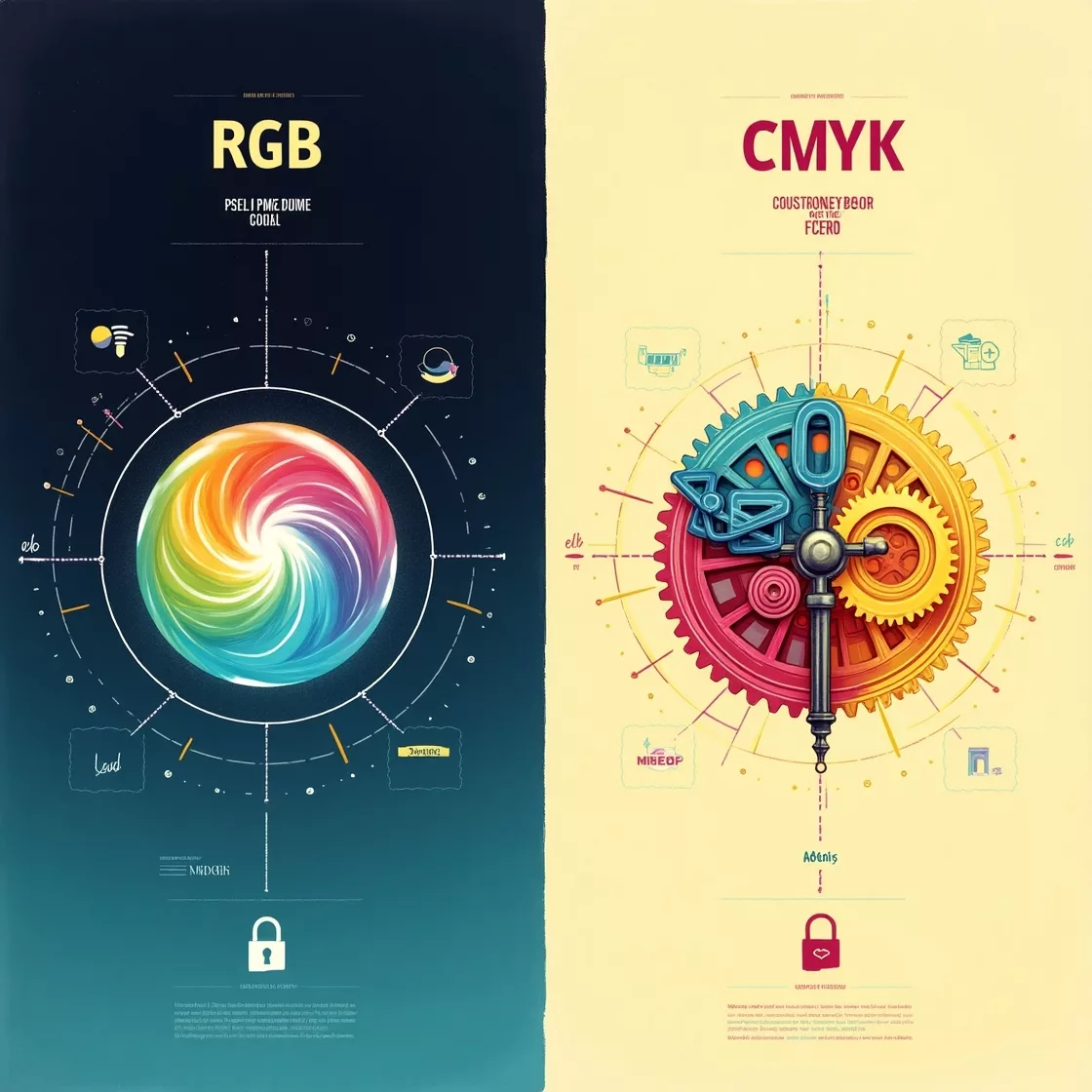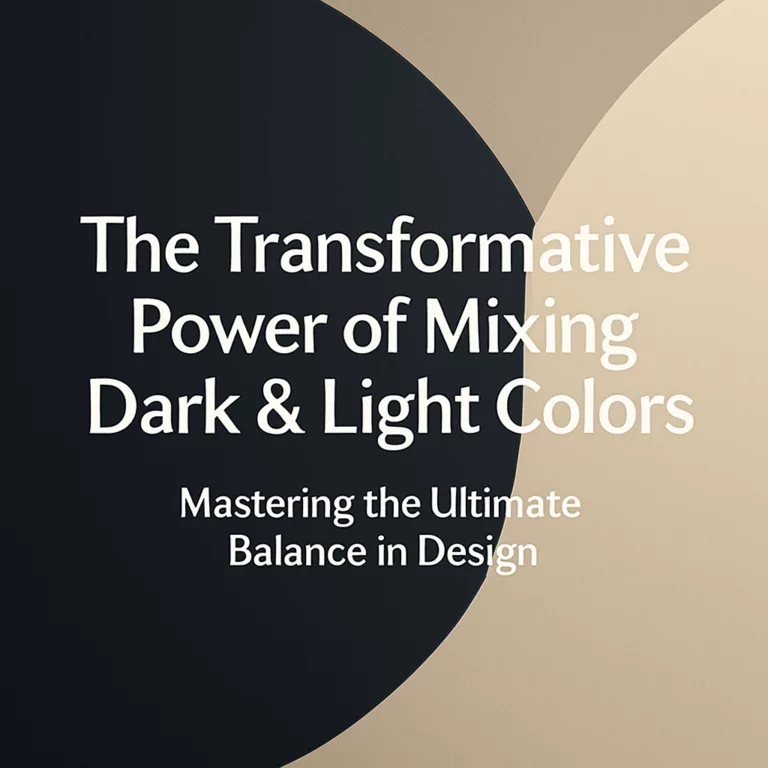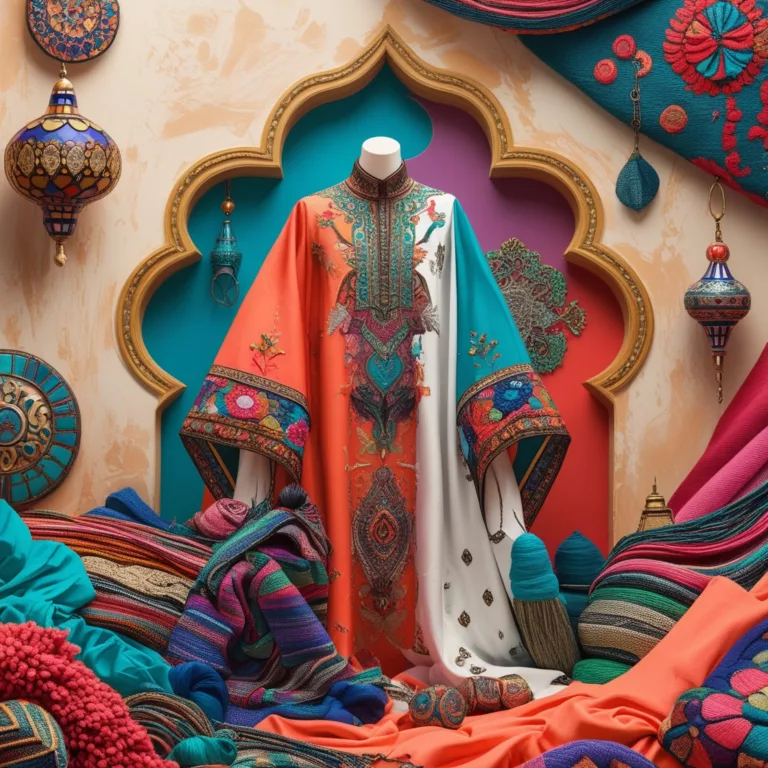Basic Color Theory: Analysis of RGB and CMYK Models
Unlocking the Essential Principles Behind Digital and Print Color Systems
Basic color theory forms the foundation of visual communication across all media. Understanding how colors interact, combine, and translate between different systems is crucial for designers, photographers, printers, and digital artists alike. This comprehensive exploration focuses on the two dominant color models that shape our visual world: RGB (Red, Green, Blue) and CMYK (Cyan, Magenta, Yellow, Key/Black). These complementary systems represent fundamentally different approaches to color creation, each optimized for its specific domain.
Foundations of Color Theory
Before diving into the specifics of RGB and CMYK models, we must establish the fundamental concepts that underpin all color theory.
What is Color?
Color is the visual perception of different wavelengths of light. The visible spectrum for humans ranges approximately from 380 nanometers (violet) to 740 nanometers (red). However, color is not simply a physical property—it’s a perceptual experience created by our visual system’s interpretation of light.
The Color Wheel: A Historical Framework
The color wheel, first developed by Sir Isaac Newton in 1666, remains a crucial tool for understanding color relationships. The traditional 12-part color wheel includes:
- Primary colors: Colors that cannot be created by mixing other colors
- Secondary colors: Colors created by mixing two primary colors
- Tertiary colors: Colors created by mixing primary and secondary colors
Understanding the color wheel provides the basis for concepts such as complementary colors, analogous colors, and color harmony—all essential for effective design and artistic expression.
Color Attributes
Regardless of the color model used, colors can be described using three fundamental attributes:
- Hue: The specific wavelength of light that determines what we name a color (red, green, blue, etc.)
- Saturation: The intensity or purity of a color, from neutral gray to the most vibrant version of the hue
- Value/Brightness: The relative lightness or darkness of a color
These attributes provide a three-dimensional framework for describing the full range of color experiences.
Additive vs. Subtractive Color: The Fundamental Distinction
The most critical distinction in color theory is between additive and subtractive color mixing. This difference explains why RGB and CMYK models exist as separate systems.
Additive Color Mixing (RGB)
Additive color mixing occurs when different wavelengths of light combine. It’s called “additive” because adding all primary colors together produces white light.
- Primary colors: Red, Green, Blue
- Starting point: Darkness (black)
- Result of all primaries combined: White light
- Applications: Digital displays, stage lighting, projection systems
In additive color, colors are created by adding light to darkness. This is how our digital screens create the vast array of colors we see.
Subtractive Color Mixing (CMYK)
Subtractive color mixing occurs when pigments or dyes absorb (subtract) specific wavelengths from light. It’s called “subtractive” because adding all primary colors together subtracts all wavelengths, theoretically producing black.
- Primary colors: Cyan, Magenta, Yellow
- Starting point: Whiteness (paper or substrate)
- Result of all primaries combined: Near-black (dark brown)
- Applications: Printing, painting, physical color reproduction
In subtractive color, colors are created by subtracting light from whiteness through the application of pigments or dyes that absorb specific wavelengths.
The RGB Color Model: Illuminating Digital Displays
The RGB color model represents the foundation of digital color representation. This additive color system uses the primary colors of light—red, green, and blue—to create the full spectrum of colors visible on digital displays.
How RGB Works
Each pixel on a digital display consists of three sub-pixels: one red, one green, and one blue. By varying the intensity of each sub-pixel, the display can create millions of perceived colors:
- Red + Green = Yellow
- Red + Blue = Magenta
- Green + Blue = Cyan
- Red + Green + Blue = White
The intensity of each primary color is typically expressed on a scale of 0 to 255 (in 8-bit systems), providing 16.7 million possible color combinations (256³).
RGB Color Spaces
Not all RGB implementations are identical. Different RGB color spaces define different ranges of colors (gamuts) and have different properties:
- sRGB: The standard RGB color space developed by Microsoft and HP, designed for typical monitors and web content. It’s the most widely used RGB color space for digital content and the default for most consumer devices.
- Adobe RGB: Developed by Adobe Systems with a wider gamut than sRGB, particularly in the cyan-green region. It’s commonly used in professional photography and printing workflows.
- ProPhoto RGB: An extremely wide-gamut RGB color space that can represent more colors than the human eye can see. It’s useful for professional photography to avoid data loss during editing.
- Display P3: Developed by Apple, this color space offers about 25% more colors than sRGB and is used on many modern Apple devices.
Each color space has its own set of primary colors and white point, which defines the exact color coordinates of red, green, blue, and white within that space.
Bit Depth and Color Fidelity
The number of bits allocated per channel significantly impacts color reproduction quality:
- 8-bit color: 256 levels per channel (16.7 million colors)
- 10-bit color: 1,024 levels per channel (1.07 billion colors)
- 12-bit color: 4,096 levels per channel (68.7 billion colors)
- 16-bit color: 65,536 levels per channel (281 trillion colors)
Higher bit depths reduce banding in gradients and enable more precise color adjustments, which is crucial for professional image editing and color grading.
RGB in Web and Application Design
For web and digital applications, RGB colors are typically expressed in several formats:
- Hexadecimal: #FF0000 (red)
- RGB function: rgb(255, 0, 0) (red)
- RGBA function: rgba(255, 0, 0, 1.0) (red with full opacity)
- HSL function: hsl(0, 100%, 50%) (red in hue-saturation-lightness format)
These expressions provide designers with multiple ways to specify the same colors, each with particular advantages for different applications.
The CMYK Color Model: The Foundation of Printing
While RGB dominates the digital world, CMYK forms the backbone of the printing industry. This subtractive color model uses four ink colors—cyan, magenta, yellow, and black (key)—to reproduce the visible spectrum on physical media.
How CMYK Works
In CMYK printing, each of the four inks absorbs (subtracts) specific wavelengths of light:
- Cyan ink absorbs red light, reflecting blue and green (which appears as cyan)
- Magenta ink absorbs green light, reflecting red and blue (which appears as magenta)
- Yellow ink absorbs blue light, reflecting red and green (which appears as yellow)
- Black ink (K) absorbs most light, creating dark areas and true blacks
The combination of these inks in varying percentages creates the full range of printable colors:
- Cyan + Magenta = Blue
- Cyan + Yellow = Green
- Magenta + Yellow = Red
- Cyan + Magenta + Yellow = Dark brown (not pure black)
Why Black Ink (K)?
Although theoretically, combining cyan, magenta, and yellow should produce black, practical limitations result in a muddy dark brown. Black ink (K) is added for several critical reasons:
- True blacks: Pure black ink provides deeper, truer blacks than CMY combination
- Text sharpness: Black ink ensures crisp text reproduction
- Cost efficiency: Black ink is less expensive than colored inks
- Reduced ink load: Using K reduces the total amount of ink applied to paper
- Enhanced contrast: Black ink improves overall image contrast
The “K” designation for black comes from “Key” plate in traditional four-color printing, which contained the detail (key) information of the image.
CMYK Color Gamut Limitations
A significant challenge with CMYK is its limited color gamut compared to RGB. Many vibrant colors achievable in RGB simply cannot be reproduced in CMYK:
- Bright oranges and reds often appear duller in CMYK
- Vibrant blues and purples may shift toward more muted tones
- Highly saturated greens frequently lose vibrancy
This gamut limitation is a fundamental constraint of physical pigments compared to light-emitting displays.
Advanced CMYK Printing Techniques
To overcome some CMYK limitations, various enhanced printing techniques have been developed:
- Extended Gamut Printing: Adding orange, green, and violet inks (CMYK+OGV or Hexachrome) to expand the reproducible color range
- Spot Colors: Using pre-mixed inks (like Pantone colors) for specific brand colors that cannot be accurately reproduced with CMYK
- High-Fidelity Printing: Using additional diluted inks to improve tonal transitions
- Variable Black Generation: Optimizing the black channel usage for different image types
These techniques help printers achieve results closer to the vibrant colors seen on digital displays.
Converting Between RGB and CMYK
The translation between RGB and CMYK represents one of the most challenging aspects of digital-to-print workflows. This conversion is not merely a mathematical formula but a complex process that requires understanding color management principles.
Why Conversion is Necessary
Since RGB and CMYK represent fundamentally different approaches to color creation, translation between them is essential when:
- Preparing digital designs for physical printing
- Scanning physical media for digital display
- Ensuring color consistency across different output methods
The Conversion Process
Color conversion typically involves these steps:
- Source profile identification: Defining the exact RGB or CMYK color space of the original
- Destination profile selection: Choosing the target color space
- Rendering intent application: Deciding how to handle out-of-gamut colors
- Color transformation: Converting colors using color management systems
Rendering Intents
When converting between color spaces with different gamuts, rendering intents determine how out-of-gamut colors are handled:
- Perceptual: Compresses the entire color gamut to preserve visual relationships between colors
- Relative Colorimetric: Maintains in-gamut colors exactly and clips out-of-gamut colors to the nearest reproducible hue
- Absolute Colorimetric: Similar to relative but maintains the white point, useful for proofing
- Saturation: Preserves saturation at the expense of accuracy, useful for business graphics
The choice of rendering intent significantly impacts the appearance of the converted image.
Common Conversion Challenges
Several issues commonly arise when converting between RGB and CMYK:
- Gamut clipping: Vibrant RGB colors may become dull when converted to CMYK
- Color shifts: Specific hues may change slightly during conversion
- Shadow detail loss: Fine details in dark areas may be lost
- Gray balance issues: Neutral grays in RGB may develop color casts in CMYK
Professional color management workflows address these challenges through calibrated devices, custom profiles, and soft-proofing.
Color Management Systems
Color management systems (CMS) provide the infrastructure for consistent color reproduction across different devices and color models.
Components of Color Management
Effective color management requires several interconnected elements:
- Device profiles: ICC profiles that describe how specific devices reproduce color
- Profile Connection Space (PCS): A device-independent color space that serves as an intermediary
- Color Management Module (CMM): Software that performs the actual color transformations
- Rendering intents: Methods for handling color gamut differences
ICC Profiles
International Color Consortium (ICC) profiles are standardized files that characterize how devices reproduce color. They come in several types:
- Input profiles: For scanners and digital cameras
- Display profiles: For monitors and projectors
- Output profiles: For printers and presses
- Abstract profiles: For special color effects or corrections
These profiles allow color management systems to predict and adjust for the specific color reproduction characteristics of each device.
Calibration and Profiling
Creating accurate color management requires:
- Device calibration: Setting devices to known, stable states
- Profiling: Creating ICC profiles through measurement of color patches
- Profile validation: Testing profile accuracy with reference targets
- Regular maintenance: Recalibrating and reprofiling as needed
Professional color management equipment includes spectrophotometers, colorimeters, and specialized software.
RGB and CMYK in Professional Workflows
Different industries have developed specialized workflows to manage the relationship between RGB and CMYK color models.
Photography Workflow
Most photographic workflows follow this path:
- Capture: Images recorded in camera RGB (often RAW format)
- Editing: Processing in a wide-gamut RGB space like ProPhoto RGB
- Output preparation: Conversion to appropriate output color space
- sRGB for web and general digital display
- Adobe RGB for high-quality printing
- CMYK for commercial printing
This approach preserves maximum color information throughout the editing process.
Graphic Design Workflow
Graphic designers often work with mixed workflows:
- Creation: Designing in RGB for maximum creative flexibility
- Asset integration: Incorporating photography, illustrations, and typography
- Color checking: Using soft-proofing to preview CMYK appearance
- Output preparation: Converting to appropriate CMYK profile for specific printing conditions
Modern design applications support color-managed workflows with embedded profiles.
Print Production Workflow
Commercial printing workflows emphasize color accuracy and consistency:
- File receipt: Validating incoming files and embedded profiles
- Preflight: Checking color spaces, embedded images, and potential issues
- Color conversion: Transforming colors to the specific press profile
- Proofing: Creating contract proofs that simulate final output
- Press matching: Adjusting press conditions to match approved proofs
Large printing operations often implement sophisticated color management systems with custom press profiles.
RGB Color Space Variations
The RGB model encompasses several color spaces with different characteristics and purposes.
Standard RGB (sRGB)
Developed by Microsoft and HP in 1996, sRGB has become the default color space for most digital content:
- Gamut: Relatively small but suitable for typical consumer displays
- White point: D65 (6500K)
- Gamma: Approximately 2.2
- Usage: Web content, consumer cameras, most monitors
Despite its limitations, sRGB provides consistency across typical consumer devices and platforms.
Adobe RGB (1998)
Created by Adobe Systems to encompass most colors achievable on CMYK printers:
- Gamut: Approximately 35% larger than sRGB, especially in cyan-green regions
- White point: D65 (6500K)
- Gamma: 2.2
- Usage: Professional photography, high-quality printing workflows
Adobe RGB captures more printable colors than sRGB, making it valuable for print-oriented workflows.
ProPhoto RGB
Developed by Kodak, ProPhoto RGB offers an extremely wide gamut:
- Gamut: Encompasses approximately 90% of visible colors
- White point: D50 (5000K)
- Gamma: 1.8
- Usage: Professional photography, archival storage, high-end retouching
ProPhoto RGB can represent colors outside human vision, providing headroom for extensive editing.
CMYK Standards and Specifications
Unlike RGB, which primarily varies by color space definition, CMYK varies by physical printing conditions.
Standard CMYK Specifications
Several standard specifications define commonly used CMYK working spaces:
- SWOP (Specifications for Web Offset Publications): The North American standard for publication printing
- FOGRA39/47: European standards for coated and uncoated papers
- GRACoL (General Requirements for Applications in Commercial Offset Lithography): Standards for commercial printing
- Japan Color: Japanese printing standards
These specifications define ink limits, dot gain expectations, and color reproduction characteristics for specific printing conditions.
Total Ink Coverage
A critical aspect of CMYK printing is managing the total amount of ink applied to paper:
- Commercial sheet-fed printing: Typically 300-350% maximum total ink coverage
- Web press printing: Often 280-300% maximum coverage
- Newspaper printing: Usually limited to 240-260% coverage
Exceeding these limits can cause drying problems, smearing, and paper distortion.
Device-Dependent Color
Unlike standardized RGB color spaces, CMYK is inherently device-dependent. The same CMYK values will produce different colors on:
- Different printing presses
- Different paper stocks
- Different ink formulations
- Different printing technologies (offset, digital, flexography, etc.)
This variability necessitates custom profiles for specific printing conditions.
Historical Development of RGB and CMYK Models
Understanding the historical development of these color models provides context for their current implementations.
Evolution of RGB Model
The RGB color model evolved alongside our understanding of human vision and technology:
- 1802: Thomas Young proposes the trichromatic theory of color vision
- 1861: James Clerk Maxwell creates the first color photograph using red, green, and blue filters
- 1940s: Color television development standardizes RGB as a display technology
- 1980s-1990s: Computer displays adopt RGB as the standard color model
- 1996: sRGB standard established for consistent cross-platform color
This evolution parallels our increasing understanding of additive color mixing and digital display technologies.
Evolution of CMYK Model
The CMYK model developed through printing industry advancements:
- 15th century: Early printers use black ink only
- 18th-19th centuries: Development of three-color printing processes
- 1906: Eagle Printing Ink Company introduces the first four-color process inks
- 1934: Introduction of modern process color standards
- 1970s-1980s: Development of computerized color separation technologies
- 1990s-2000s: Digital prepress systems standardize CMYK workflows
The CMYK model represents centuries of refinement in printing technology.
RGB and CMYK Applications in Different Industries
Different industries leverage RGB and CMYK models according to their specific needs.
Web and Digital Media
Digital content creation relies almost exclusively on RGB:
- Web design: HTML/CSS color specifications in RGB/Hex
- UI/UX design: RGB values with alpha channel for transparency
- Video production: RGB color grading with specialized RGB color spaces
- Video games: Real-time RGB rendering with HDR capabilities
The additive nature of RGB perfectly suits light-emitting displays.
Print Media
Print production leverages sophisticated CMYK workflows:
- Magazines: High-quality CMYK with spot colors for covers
- Newspapers: Lower ink density CMYK for absorbent papers
- Packaging: Extended gamut printing (CMYK+OGV) for vibrant packaging
- Books: CMYK with careful black generation for text-heavy content
Each print application requires specific CMYK optimization strategies.
Cross-Media Publishing
Modern content often appears across multiple media types:
- Brand management: Defining equivalent colors in both RGB and CMYK
- Responsive design: Ensuring color consistency across devices
- Asset management: Maintaining color-managed files for various outputs
- Soft proofing: Simulating CMYK appearance on RGB displays
Cross-media workflows require sophisticated color management to maintain visual consistency.
Future Directions in Color Models
Both RGB and CMYK continue to evolve as technology advances.
Extended Color Gamuts
Recent developments focus on expanding reproducible color ranges:
- Wide-gamut RGB displays: Technologies like quantum dots enable display of more saturated colors
- HDR (High Dynamic Range): Expanded brightness and contrast ranges in RGB displays
- Extended gamut printing: Seven-color printing (CMYK+OGV) for packaging and specialty applications
- Spectral printing: Multi-channel inkjet printing using more than four inks
These technologies aim to represent more of the visible color spectrum in both digital and print media.
Advanced Color Management
Emerging color management approaches include:
- Spectral-based color management: Moving beyond XYZ-based color representations
- AI-powered color mapping: Using machine learning to improve gamut mapping
- Display-referred workflows: Preserving HDR and wide-gamut information throughout the production process
- Personalized color management: Adjusting for individual color perception differences
These advances promise more accurate color reproduction across diverse media.
Practical Applications of Color Theory
Beyond technical considerations, understanding RGB and CMYK enables better creative decisions.
Design Principles
Knowledge of color models informs effective design:
- Color harmony: Creating pleasing color combinations based on color wheel relationships
- Visual hierarchy: Using color to guide viewer attention
- Accessibility: Ensuring sufficient contrast for readability
- Emotional impact: Leveraging color psychology for communication objectives
These principles apply whether working in RGB or CMYK.
Common Pitfalls and Solutions
Awareness of color model limitations helps avoid common problems:
- Monitoring out-of-gamut colors: Using gamut warnings during design
- Planning for color shifts: Designing with color conversion in mind
- Testing print colors: Creating proofs before final production
- Establishing color standards: Developing organization-wide color guidelines
Proactive color management prevents costly errors and disappointments.
Conclusion: The Complementary Nature of RGB and CMYK
The RGB and CMYK color models represent two sides of the same coin—complementary approaches to color creation optimized for different media. While RGB creates color by adding light in digital displays, CMYK creates color by subtracting light using physical pigments on printed materials. Understanding both models enables professionals to work effectively across the digital-physical divide.
As technology continues to advance, the boundaries between these color models may blur, but their fundamental principles remain essential knowledge for anyone working with visual media. Whether designing websites, creating digital art, or preparing materials for print, mastery of basic color theory—particularly the RGB and CMYK models—forms the foundation for successful visual communication.
By appreciating the strengths, limitations, and appropriate applications of each color model, designers, artists, and content creators can make informed decisions that optimize their work for its intended medium, ensuring that their creative vision translates effectively from concept to final output.
References and Further Reading
- Adams, R. M., & Weisberg, J. B. (2000). The GATF Practical Guide to Color Management. GATF Press.
- Fraser, B., Murphy, C., & Bunting, F. (2005). Real World Color Management (2nd ed.). Peachpit Press.
- Hunt, R. W. G., & Pointer, M. R. (2011). Measuring Colour (4th ed.). Wiley.
- Itten, J. (1970). The Elements of Color. Van Nostrand Reinhold Company.
- Kang, H. R. (2006). Computational Color Technology. SPIE Press.
- Sharma, A. (2018). Understanding Color Management (2nd ed.). Wiley.
- Stone, M. C. (2003). A Field Guide to Digital Color. A K Peters/CRC Press.
- International Color Consortium. (2004). ICC Profile Format Specification. www.color.org/specification/ICC.1-2004-10.pdf
- Adobe Systems Incorporated. (2005). Adobe RGB (1998) Color Image Encoding. www.adobe.com/digitalimag/pdfs/AdobeRGB1998.pdf
- Fairchild, M. D. (2013). Color Appearance Models (3rd ed.). Wiley.
This article provides a comprehensive overview of basic color theory with a focus on RGB and CMYK models. For the most current standards and practices, readers are encouraged to consult industry publications and color management organizations.







